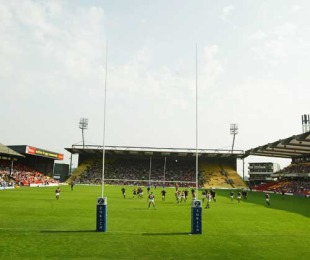- Back to Home »
- attendances , aviva premiership , club news , features , pro12 , rugby »
- Tackling Rugby's Attendance Problem
29 January 2012
 Empty seats have become a sight far too common in the modern rugby game. The World Cup last year helped to increase rugby's exposure with large media attention but attendances for first division matches have become disappointingly low.
Empty seats have become a sight far too common in the modern rugby game. The World Cup last year helped to increase rugby's exposure with large media attention but attendances for first division matches have become disappointingly low.
One of the key issues in the professional era of rugby union is the low attendances of the top leagues in the Northern Hemisphere. The largest stadium in the Aviva Premiership is the Madejski Stadium, a football stadium, with a capacity of 24,161.
Welford Road, surprisingly not a football stadium, is Leicester's home ground and holds 24,000 people. Another football stadium, Vicarage Road, holds just shy of 20,000 and Kingsholm, a rugby stadium, has the fourth largest capacity with 16,500.
The point being made here is even with these large stadiums like the Madejski Stadium and Vicarage Road, which are coincidentally both football stadiums, rarely reach more than 10,000 ticket sales despite boasting large capacities.
In Saracens' last home fixture in the Aviva Premiership they beat Bath 26-19 in front of just 5,799 people at Vicarage Road. That attendance leaves almost 15,000 empty seats.
Rugby clubs traditionally have strong communities of fans yet still have low attendances. Big tournaments such as the Six Nations help to boost ticket sales for clubs with rugby taking centre stage throughout the duration of the tournament.
The 2015 Rugby World Cup will also help to promote English rugby, allowing cities like Manchester, traditionally a football city, experience world class rugby union and may encourage more to watch live rugby in the future.
The RaboDirect Pro12 is a victim of low crowds. The Welsh clubs are unfortunate in having to share stadiums with big football clubs. Ospreys share the Liberty Stadium with Barclays Premier League club, Swansea and Cardiff Blues use the Cardiff City Stadium which is primarily used for Cardiff City's football endeavours.
The Cardiff City Stadium has a capacity of 26,828 and Cardiff Blues have had an average attendance of just 9,380 in their last three matches which include their crucial Round 6 Heineken Cup match against Racing Metro and an encounter with European Champions, Leinster.
Cardiff City on the other hand have had an average attendance of 23,835 in their last three matches.
Edinburgh is another club struggling to get high attendances in the Pro 12. They play their home fixtures at Murrayfield, the home of Scottish rugby and Scotland's home ground for the Six Nations. Murrayfield holds just over 67,000 people but Edinburgh fail to even come close to that number.
 Edinburgh's last game against London Irish in the Heineken Cup saw an attendance of 10,892 – a Heineken Cup record for Edinburgh but still low in comparison with other European clubs.
Edinburgh's last game against London Irish in the Heineken Cup saw an attendance of 10,892 – a Heineken Cup record for Edinburgh but still low in comparison with other European clubs.
Their previous fixture against Ulster back in the domestic league had an attendance of just 3,792 and in their match against Scottish rivals, Glasgow Warriors they achieved a Scottish league record of 13,240 – just a few hundred more than the tickets sold at Kingsholm for Gloucester's comparatively smaller fixture against Cardiff in the Anglo Welsh Cup last week.
So the question is: what can be done to tackle rugby's low attendances? One thing is for certain, it's not a lack of support; you only have to visit a social network like Twitter to see the amount of rugby fans there are.
However, the amount of support does not necessarily translate into the number of people attending a particular fixture. Tickets certainly aren't too expensive but perhaps widening rugby's exposure across all parts of the country, especially those parts that are dominated by the money fuelled sport of football.
However, the amount of support does not necessarily translate into the number of people attending a particular fixture. Tickets certainly aren't too expensive but perhaps widening rugby's exposure across all parts of the country, especially those parts that are dominated by the money fuelled sport of football.
Maybe the best way of ensuring large numbers are at rugby matches is going straight to the youngsters. If they can be attracted to live local rugby matches by school schemes and local rugby projects then that is surely the best method of securing supporters who will ideally become lifelong rugby fans.








